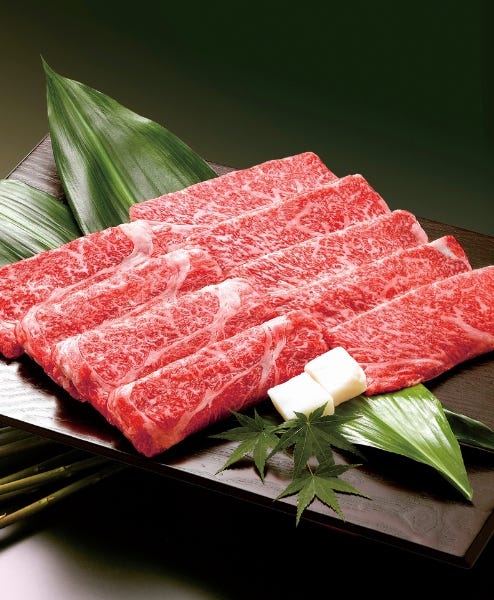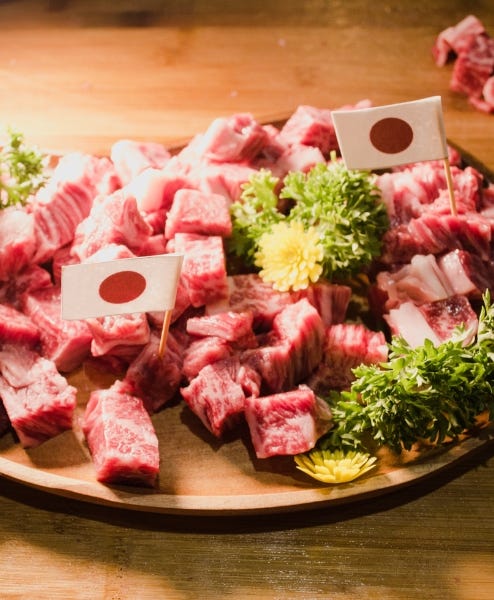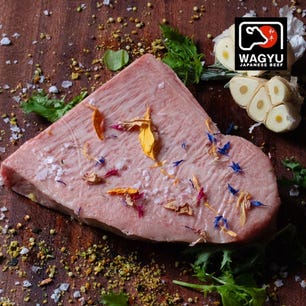Japanese Kobe Beef
WAGYU BEEF
Kobe Beef: the exquisite Japanese meat with extraordinary marbling
Japanese Kobe Beef is a prized meat, known worldwide for its extraordinary tenderness and flavor. It is important to note that not all Wagyu meat is Kobe. Kobe is derived from a breed of cattle called Wagyu, which originated in Japan, more specifically in Hyogo Prefecture, whose capital is the city of Kobe. The term "Wagyu" literally translates to "Japanese cow" and refers to several breeds of cattle originating in Japan. Kobe beef comes from the Tajima breed, one of the most valuable Wagyu breeds, genetically predisposed to produce high marbling and superior meat quality compared to other Wagyu breeds.
The genetics of these cattle are unique, characterized by a natural tendency to accumulate intramuscular fat, which results in extraordinary meat marbling. The breeding of Wagyu cattle is a careful and meticulous process; in fact, Japanese breeders strive to create a comfortable and relaxed environment for the animals, often providing them with ample space. And it is also this approach to farming that contributes to the quality of Kobe meat.
Wagyu cattle are fed a special diet that may include grain and hay. This diet helps to further enhance the marbling of the meat and give it an unmistakable flavor. In Wagyu Kobe, the marbling is particularly high, which gives the meat a soft, almost melt-in-your-mouth texture.




The Kobe beef standards: guarantee of authenticity and quality
The Kobe beef specification covers a set of strict rules and quality standards that must be met to ensure the authenticity and excellence of the product. These rules apply to various aspects of production, from raising cattle to slaughtering, and grading and selling the meat. Compliance with these rules and standards of the Kobe beef specification ensures that the meat is of the highest quality and authentic, offering consumers a unique and satisfying dining experience. Here are some of the main criteria of the Kobe beef specification:
- Origin of cattle: Kobe beef must come from cattle of the Tajima breed, born and raised in Hyogo Prefecture.
- Animal husbandry and welfare: cattle must be raised according to methods that ensure their welfare and meat quality. This includes access to adequate space, regular veterinary care and ethical husbandry practices.
- Diet: the diet of Kobe cattle must be carefully controlled; a balanced diet contributes to marbling and meat quality.
- Slaughtering and processing: slaughtering and processing of Kobe beef must be carried out in licensed and certified facilities in Hyogo Prefecture. These facilities must follow strict hygiene and quality standards.
- Grading: Kobe beef must meet certain grading requirements to be considered authentic. These requirements mainly concern the degree of intramuscular fat, texture and color of the meat. The grading system used for Kobe beef is based on a scale ranging from A1 to A5, with A5 representing the highest quality.
- Certification: in order to ensure the authenticity and quality of Kobe beef, the meat must be accompanied by a certification issued by the organization responsible for the inspection and promotion of Kobe beef in Hyogo Prefecture.


Kobe beef: the king of fine meats in Hyogo prefecture
Hyogo Prefecture, home of the renowned kobe beef, is located in the Kansai region on the island of Honshu, Japan. Hyogo is characterized by a wide variety of landscapes, ranging from snow-capped mountains and lush forests to sandy coastlines and charming urban centers. The prefecture is divided into several geographical areas, including the Kobe-Awaji-Naruto Plain, the Harima Plain, and the mountainous Tajima region.
Kobe, the capital of Hyogo Prefecture, is one of Japan's most important port cities and an economic and cultural center. It is known for its Western architecture, trendy neighborhoods, and vibrant food scene.
But what makes the kobe beef so special compared to other breeds of cattle?
First, the genetic selection of the Tajima breed of cattle was influenced by the geography of the region: characterized by rocky terrain and few pastures, this environment favored the development of firm muscles in cattle and the accumulation of abundant fat, a good trait for animals destined for slaughter. In the past, these cattle were used as labor force, which further contributed to the evolution of their intramuscular fat, known precisely as marbling.
Respect for animals is a deeply rooted value in Japanese culture, and this is particularly evident in the Kobe region, where great attention is paid to raising these prized cattle. Kobe beef is known to be one of the finest meats in the world, however, there are other cattle breeds that produce the highest quality meat such as Black Angus and Rubia Gallega, but the marbling of these breeds does not compare to that of Kobe beef.


The ultimate guide to cooking the prized Kobe beef
To make the most of the organoleptic and taste qualities of the delicious kobe beef, it is important to follow some recommendations when preparing and cooking Kobe beef. Meanwhile, let's start with the choice of cut, the first thing to consider is definitely personal taste. Some of the most popular cuts for this meat include tenderloin, rib eye, and steak. Each cut has different characteristics and requires slightly different cooking techniques to bring out its flavor and tenderness. Before you start cooking Kobe beef, it is important to let it rest at room temperature for at least 30 minutes. This allows the meat to reach an even temperature, ensuring more even cooking and a more satisfying end result. Kobe beef is a very fatty meat, and its marbling makes fast, high-temperature cooking the ideal choice. The most recommended cooking technique to enhance the flavor of Kobe beef is grilling or pan-frying. Heat the grill or skillet over medium-high heat and cook the meat for 2-3 minutes per side, depending on the thickness of the cut and personal preference. It is important not to overcook Kobe beef, as prolonged cooking may compromise its characteristic tenderness.
After cooking Kobe beef, let it rest for a few minutes before cutting it. This allows the juices to distribute evenly in the meat, ensuring a juicier and tastier result. Finally, Kobe beef is a very flavorful and rich meat, so it is best served with simple seasonings that do not cover up the flavor. A pinch of salt and pepper is often enough to enhance the flavor of the meat. For accompaniments, choose light and fresh vegetables, such as salad or steamed vegetables, and simple carbohydrates such as rice or baked potatoes. However, if you wish to experiment with Kobe beef, you can try using it in different recipes such as sushi, carpaccio, or tartare.
Discover the products
Longino & Cardenal
Longino & Cardenal stands today as one of Italy's leading "food globetrotters." With passion and courage it carries out a continuous search for the best raw materials, often little known to most, in order to meet the new trends in consumer behavior that seek excellent products proposed in innovative forms. Delivery of products is expected in 48/72 hours from the order if the product is already in stock. All our deliveries use specialized, refrigerated couriers.








